A Prediction Model for Soil–Water Characteristic Curve Based on Machine Learning Considering Multiple Factors
Abstract
1. Introduction
2. Construction of Neural Network Prediction Model
2.1. Data Collection and Processing
2.2. Model Building
2.3. Neural Network Training
3. Analysis of Model Predictive Ability
3.1. SWCC Prediction Considering Salinity and Deformation Effects
3.2. SWCC Prediction Considering Temperature and Deformation Effects
3.3. SWCC Prediction Considering Temperature, Deformation, and Salinity Effects
4. Conclusions and Discussion
- (1)
- Using neural network machine learning methods to train a large number of SWCC test results under complex environments, a SWCC prediction model that can consider the effects of multiple factors such as temperature, salinity, and deformation was obtained. The model selects the representative particle sizes d10/d30/d60, plasticity index, initial moisture content, void ratio, temperature, salinity, and matrix suction of the soil as input variables, and the volumetric moisture content as the output variable.
- (2)
- To improve the prediction accuracy of the model, separate training models were established for the SWCC considering temperature and deformation effects, as well as the SWCC considering salinity and deformation effects, for prediction analysis. By comparing the prediction results of the established model for SWCC characteristics under temperature, salinity, and deformation factors with relevant experimental results, including the effects of two factors and the combined effects of three factors, the validity of the model was verified.
- (3)
- The model directly takes environmental variables and the physical properties of the soil as inputs, overcoming the problem of poor prediction accuracy caused by the excessive number of parameters in traditional empirical formulas due to the increase in variables. In addition, this method takes suction conditions as input eigenvalues, which can directly obtain the corresponding water content under certain conditions, making it simpler and more direct.
Author Contributions
Funding
Data Availability Statement
Conflicts of Interest
References
- Fredlund, D.G.; Rahardjo, H. Unsaturated Soil Mechanics in Engineering Practice; John Wiley & Sons, Inc.: Hoboken, NJ, USA, 2012. [Google Scholar]
- Zhai, Q.; Rahardjo, H.; Satyanaga, A.; Zhu, Y.; Dai, G.; Zhao, X. Estimation of wetting hydraulic conductivity function for unsaturated sandy soil. Eng. Geol. 2021, 285, 106034. [Google Scholar] [CrossRef]
- Satyanaga, A.; Rahardjo, H. Unsaturated shear strength of soil with bimodal soil water characteristic curve. Géotechnique 2019, 69, 828–832. [Google Scholar] [CrossRef]
- Al-Mahbashi, A.M.; Elkady, T.; Al-Shamrani, M. The Role of Stress States on the Hysteric Behavior of Expansive Soil under Multiple Drying-Wetting Cycles. Buildings 2023, 13, 1619. [Google Scholar] [CrossRef]
- Fredlund, D.G.; Xing, A. Equations for the soil-water characteristic curve. Can. Geotech. J. 1994, 31, 521–532. [Google Scholar] [CrossRef]
- Van Genuchten, M.T. A closed-form equation for predicting the hydraulic conductivity of unsaturated soils. Soil Sci. Soc. Am. J. 1980, 44, 892–898. [Google Scholar] [CrossRef]
- De la Morena, G.; Navarro, V.; Asensio, L.; Gallipoli, D. A water retention model accounting for void ratio changes in double porosity clays. Acta Geotech. 2021, 16, 2775–2790. [Google Scholar] [CrossRef]
- Lu, P.H.; He, Y.; Zhang, Z.; Ye, W.M. Predicting chemical influence on soil water retention curves with models established based on pore structure evolution of compacted clay. Comput. Geotech. 2021, 138, 104360. [Google Scholar] [CrossRef]
- Zhang, W.J.; Lin, M.F. Evaluating the dual porosity of landfilled municipal solid waste. Environ. Sci. Pollut. Res. 2019, 26, 12080–12088. [Google Scholar] [CrossRef]
- He, Y.F.; Lu, H.J.; Lan, J.R.; Ma, J.Y.; Liu, M.Y.; Dong, Y.Q. Macroscopic Mechanical Properties and Microstructure Characteristics of Solid Waste Base Capillary Retarded Field Covering Material. Buildings 2024, 14, 313. [Google Scholar] [CrossRef]
- Ma, C.Y.; Tang, L.B.; Chang, W.Q.; Jaffar, M.T.; Zhang, J.G.; Li, X.; Chang, Q.; Fan, J.L. Effect of Shelterbelt Construction on Soil Water Characteristic Curves in an Extreme Arid Shifting Desert. Water 2022, 14, 1803. [Google Scholar] [CrossRef]
- Zhu, J.H.; Su, Z.Y.; Zhang, H.Y. Soil-water characteristic curves and hydraulic conductivity of Gaomiaozi bentonite pellet-contained materials. Environ. Earth Sci. 2022, 81, 92. [Google Scholar] [CrossRef]
- Andry, H.; Yamamoto, T.; Irie, T.; Moritani, S.; Inoue, M.; Fujiyama, H. Water retention, hydraulic conductivity of hydrophilic polymers in sandy soil as affected by temperature and water quality. J. Hydrol. 2009, 373, 177–183. [Google Scholar] [CrossRef]
- He, Y.; Chen, Y.G.; Ye, W.M.; Chen, B.; Cui, Y.J. Influence of salt concentration on volume shrinkage and water retention characteristics of compacted GMZ bentonite. Environ. Earth Sci. 2016, 75, 535. [Google Scholar] [CrossRef]
- Pham, K.; Kim, D.; Le, C.V.; Won, J. Machine learning-based pedotransfer functions to predict soil water characteristics curves. Transp. Geotech. 2023, 42, 101052. [Google Scholar] [CrossRef]
- Gupta, S.; Papritz, A.; Lehmann, P.; Hengl, T.; Bonetti, S.; Or, D. Global Mapping of Soil Water Characteristics Parameters-Fusing Curated Data with Machine Learning and Environmental Covariates. Remote Sens. 2022, 14, 1947. [Google Scholar] [CrossRef]
- Li, Y.; Vanapalli, S.K. Prediction of soil-water characteristic curves using two artificial. Can. Geotech. J. 2022, 59, 129–143. [Google Scholar] [CrossRef]
- Uchaipichat, A.; Khalili, N. Experimental investigation of thermo-hydro-mechanical behavior of an unsaturated silt. Géotechnique 2009, 59, 339–353. [Google Scholar] [CrossRef]
- Li, X.Z. Experimental Study on Water Retention and Mechanical Behaviors of Saline Soil; Beijing Jiaotong University: Beijing, China, 2021. (In Chinese) [Google Scholar]
- Liu, Q.Q.; Li, J.; Cai, G.Q.; Li, P.L.; Li, X.Z. Experimental study on water retention characteristics of saline soil in the full suction range. Rock Soil Mech. 2021, 42, 713–722. (In Chinese) [Google Scholar]
- Zhai, Q.; Rahardjo, H. Determination of soil–water characteristic curve variables. Comput. Geotech. 2012, 42, 37–43. [Google Scholar] [CrossRef]
- Chen, P.; Liu, J.; Wei, C.F.; Xue, W.J.; Tian, H.H. Approach to Rapidly Determining the Water Retention Curves for Fine-Grained Soils in Capillary Regime Based on the NMR Technique. J. Eng. Mech. 2017, 143, 04017032. [Google Scholar] [CrossRef]
- Gallage, K.P.C.; Uchimura, T. Effects of Dry Density and Grain Size Distribution on Soil-Water Characteristic Curves of Sandy Soils. Soils Found. 2010, 50, 161–172. [Google Scholar] [CrossRef]
- Wang, M.; Pande, N.G.; Kong, W.L.; Feng, Y.T. Comparison of Pore-Size Distribution of Soils Obtained by Different Methods. Int. J. Geomech. 2016, 17, 06016012. [Google Scholar] [CrossRef]
- Antinoro, C.; Arnone, E.; Noto, L.V. The use of soil water retention curve models in analyzing slope stability in differently structured soils. CATENA 2017, 150, 133–145. [Google Scholar] [CrossRef]
- Pham, K.; Kim, D.; Yoon, Y.; Choi, H. Analysis of neural network based pedotransfer function for predicting soil water characteristic curve. Geoderma 2019, 351, 92–102. [Google Scholar] [CrossRef]
- Li, Y.Y.; Rahardjo, H.; Satyanaga, A.; Rangarajan, S.; Lee, D.T.T. Soil database development with the application of machine learning methods in soil properties prediction. Eng. Geol. 2022, 306, 106769. [Google Scholar] [CrossRef]
- Lu, P.H.; Ye, W.M.; He, Y. A constitutive model of compacted bentonite under coupled chemo-hydro-mechanical conditions based on the framework of the BExM. Comput. Geotech. 2023, 158, 105360. [Google Scholar] [CrossRef]
- Thyagaraj, T.; Rao, M.S. Influence of Osmotic Suction on the Soil-Water Characteristic Curves of Compacted Expansive Clay. J. Geotech. Geoenviron. Eng. 2010, 136, 1695–1702. [Google Scholar] [CrossRef]
- Yang, S.; Zheng, P.; Yu, Y.; Zhang, J. Probabilistic analysis of soil-water characteristic curve based on machine learning algorithms. IOP Conf. Ser. Earth Environ. Sci. 2021, 861, 062030. [Google Scholar] [CrossRef]
- Chen, Y.; Zhou, H.T.; Su, J.; Ye, R.Q.; Wang, L. Impact Analysis and Prediction Research of Soil-water Characteristic Curves Based on Data Mining. J. Basic Sci. Eng. 2023, 31, 451–466. (In Chinese) [Google Scholar]
- Prakash, A.; Hazra, B.; Sreedeep, S. Probabilistic analysis of soil-water characteristic curve using limited data. Appl. Math. Model. 2021, 89, 752–770. [Google Scholar] [CrossRef]
- Li, Y.; Vanapalli, S.K. A novel modeling method for the bimodal soil-water characteristic curve. Comput. Geotech. 2021, 138, 104318. [Google Scholar] [CrossRef]
- Ren, Q.B.; Li, M.C.; Han, S. Discrimination and comparison experiments of basalt tectonic setting based on improved genetic algorithm-optimized neural network. Earth Sci. Front. 2019, 26, 117–124. (In Chinese) [Google Scholar]
- Wang, L.; Li, D.Q.; Cao, Z.J.; Fang, G.G. Bayesian approaches for model selection and parameter identification of soil water characteristic curve. J. Basic Sci. Eng. 2019, 27, 1269–1284. (In Chinese) [Google Scholar]
- Chen, R.P.; Liu, P.; Liu, X.M.; Wang, P.F.; Kang, X. Pore-scale model for estimating the bimodal soil-water characteristic curve and hydraulic conductivity of compacted soils with different initial densities. Eng. Geol. 2019, 260, 105199. [Google Scholar] [CrossRef]
- Wang, T.H.; Lu, J.; Yue, C.K. Soil-water characteristic curve for unsaturated loess considering temperature and density effect. Rock Soil Mech. 2008, 29, 1–5. (In Chinese) [Google Scholar]
- Cai, G.Q.; Liu, Y.i.; Xu, R.Z.; Li, J.; Zhao, C.G. Experimental investigation for soil-water characteristic curve of red clay in full suction range. Chin. J. Geotech. Eng. 2019, 41, 13–16. (In Chinese) [Google Scholar]
- Sayem, H.M.; Kong, L.W. Effects of Drying-Wetting Cycles on Soil-Water Characteristic Curve. In Proceedings of the International Conference on Power Engineering and Energy, Environment (PEEE), Shanghai, China, 25–26 June 2016; pp. 607–614. [Google Scholar]
- Jiang, Y.; Chen, W.W.; Wang, G.H.; Sun, G.P.; Zhang, F.Y. Influence of initial dry density and water content on the soil–water characteristic curve and suction stress of a reconstituted loess soil. Bull. Eng. Geol. Environ. 2017, 76, 1085–1095. [Google Scholar] [CrossRef]
- Liu, W.P.; Luo, X.Y.; Fu, M.F.; Huang, J.S. Experiment and Modeling of Soil-Water Characteristic Curve of Unsaturated Soil in Collapsing Erosion Area. Pol. J. Environ. Stud. 2016, 25, 2509–2517. [Google Scholar] [CrossRef]
- Chen, R.; Tan, R.Q.; Chen, Z.K.; Ping, Y.; Mei, Z. Influence of degree of compaction on unsaturated hydraulic properties of a compacted completely decomposed granite. Geofluids 2020, 2020, 7615361. [Google Scholar] [CrossRef]
- Zhang, J.R.; Jiang, T.; Wang, X.C.; Liu, C.; Huang, Z.Q. Influences of drying and wetting cycles and compaction degree on strength of Yudong silt for subgrade and its prediction. Adv. Civ. Eng. 2018, 2018, 1364186. [Google Scholar] [CrossRef]
- Dai, Z.J.; Chen, S.X.; Luo, H.M.; Lu, D.J. Experimental study of water-holding and permeability characteristics of unsaturated expansive soils and rocks. Rock Soil Mech. 2013, 34, 134–141. (In Chinese) [Google Scholar]
- Cui, K.; Lin, W.K. Research on soil-water characteristic curve of unsaturated mixed-soil in Western Sichuan. China J. Highw. Transp. 2017, 30, 44–50. (In Chinese) [Google Scholar]
- Yao, Z.H.; Sun, F.X.; Fang, X.W.; Chen, Z.H. Water retention characteristics of unsaturated bentonite-sand mixtures under controlled-temperature. Environ. Earth Sci. 2021, 80, 315. [Google Scholar] [CrossRef]
- Gens, A. Specification of laboratory benchmark 3. Internal Document of Work Package 4. THERESA Proj. 2007, 91, 509–530. [Google Scholar]
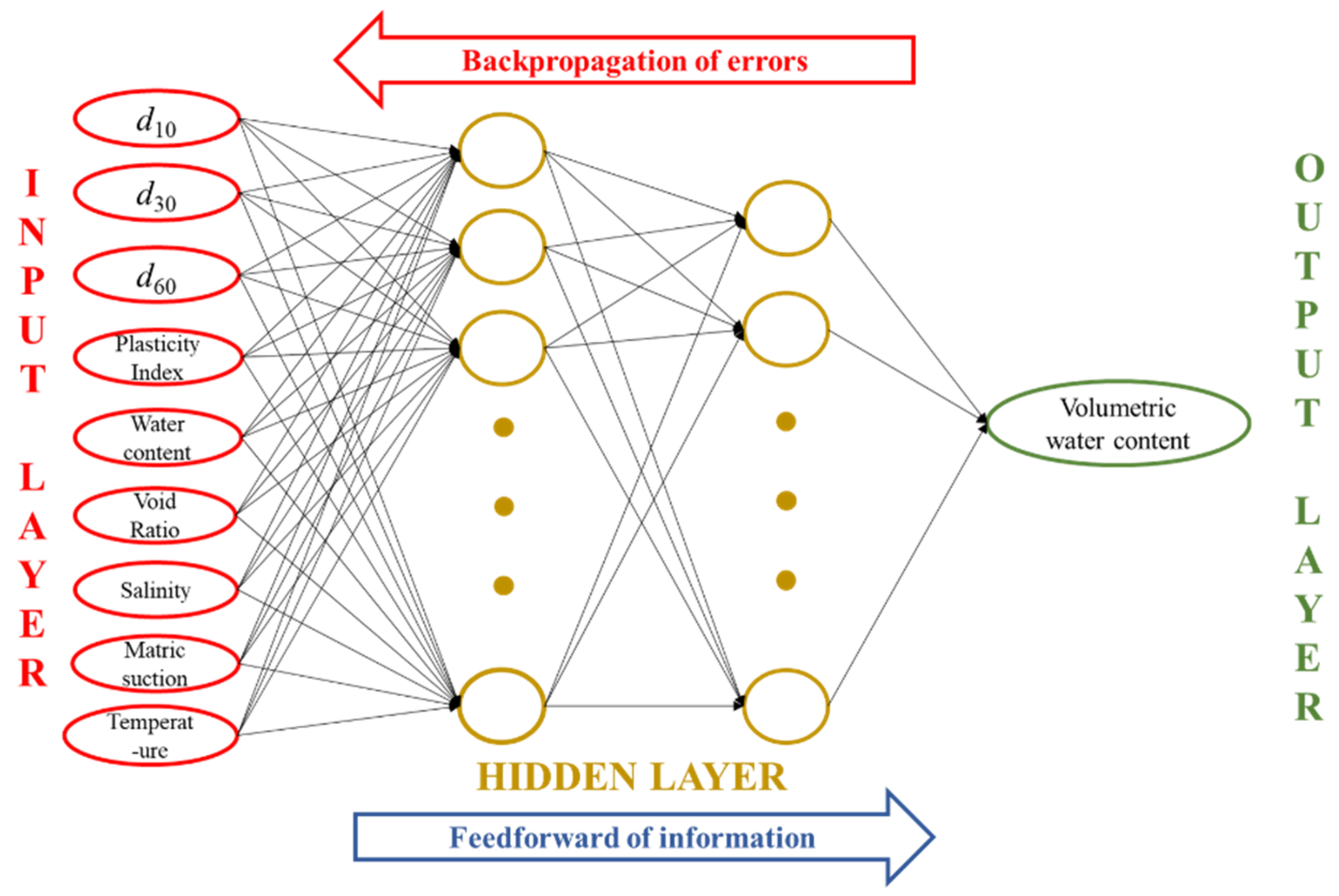
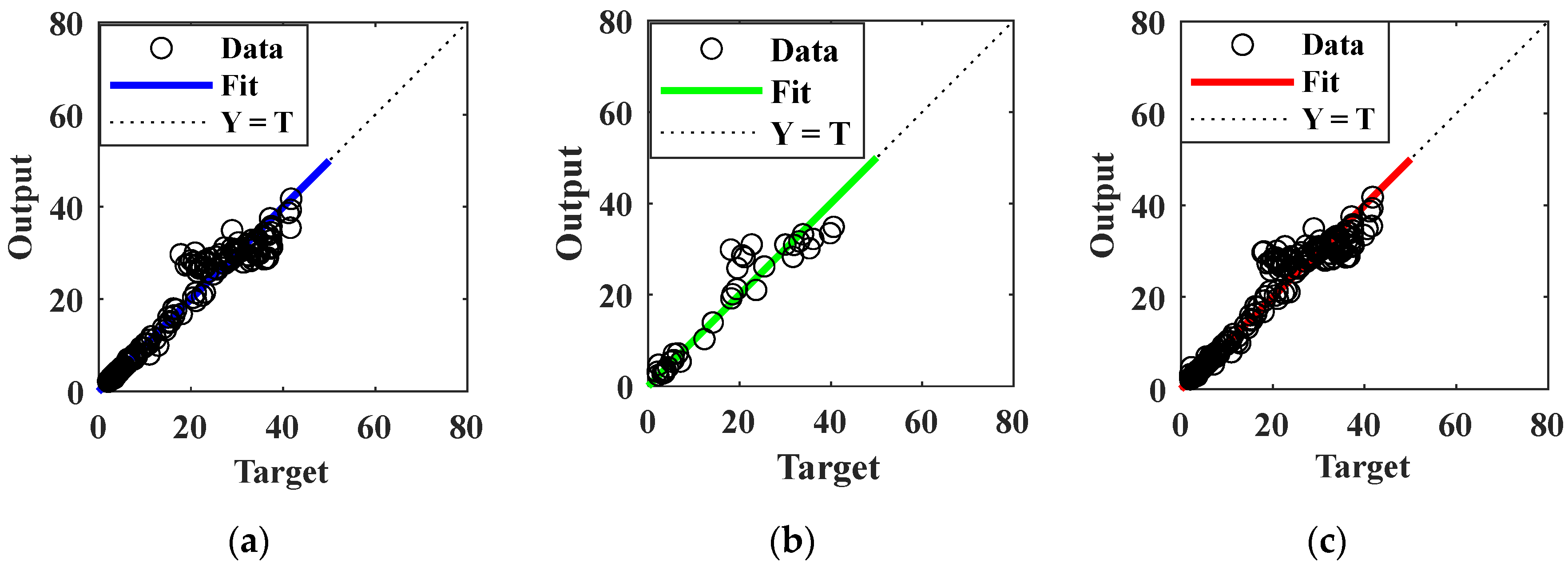
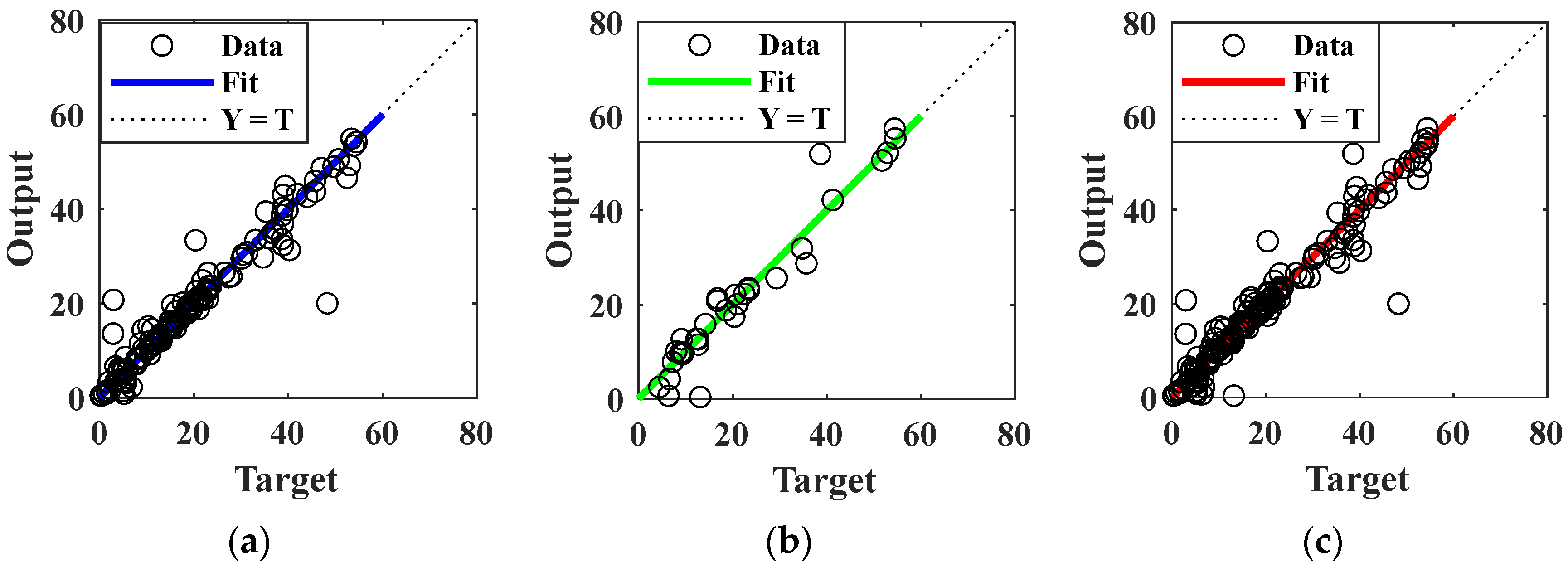

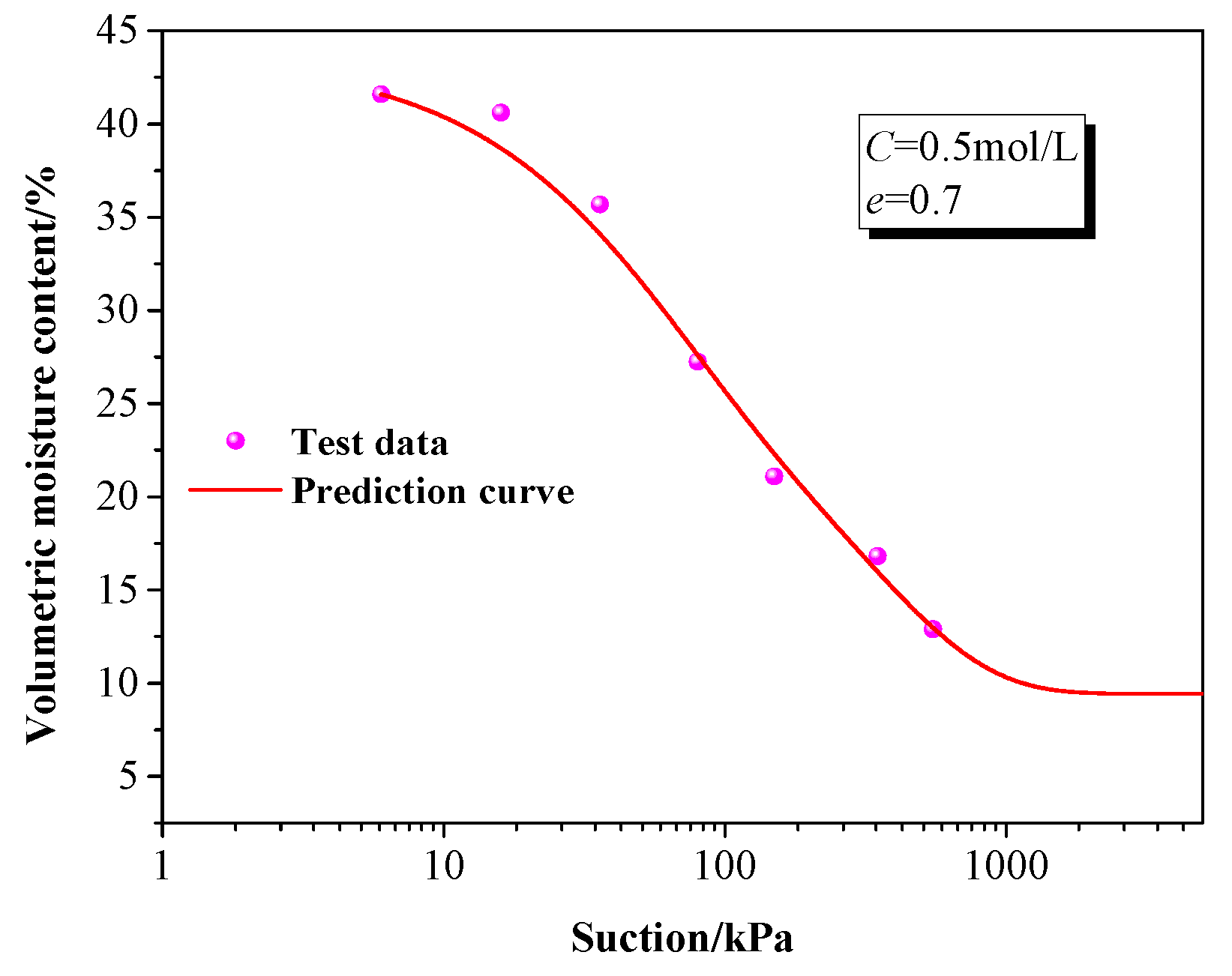

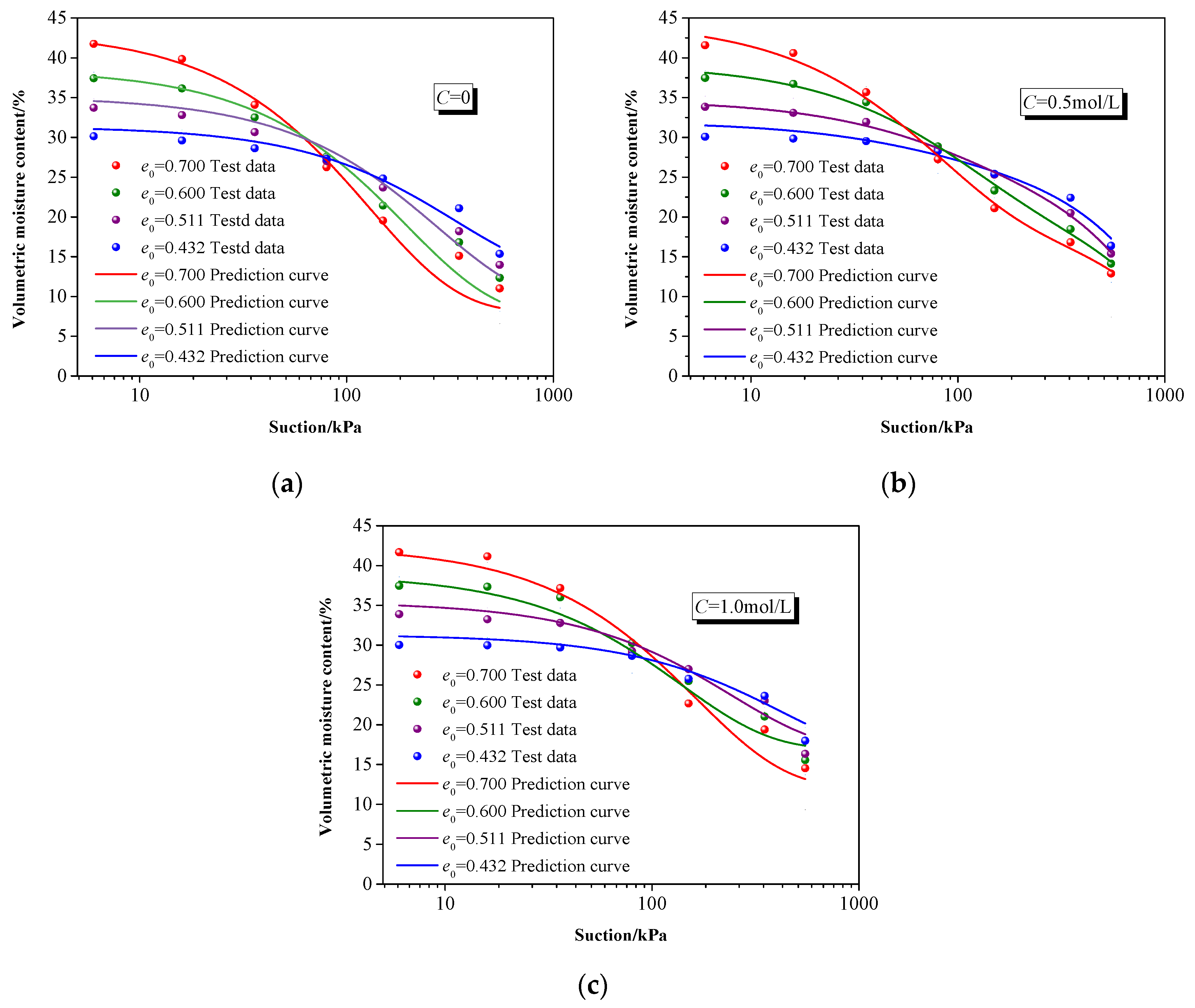

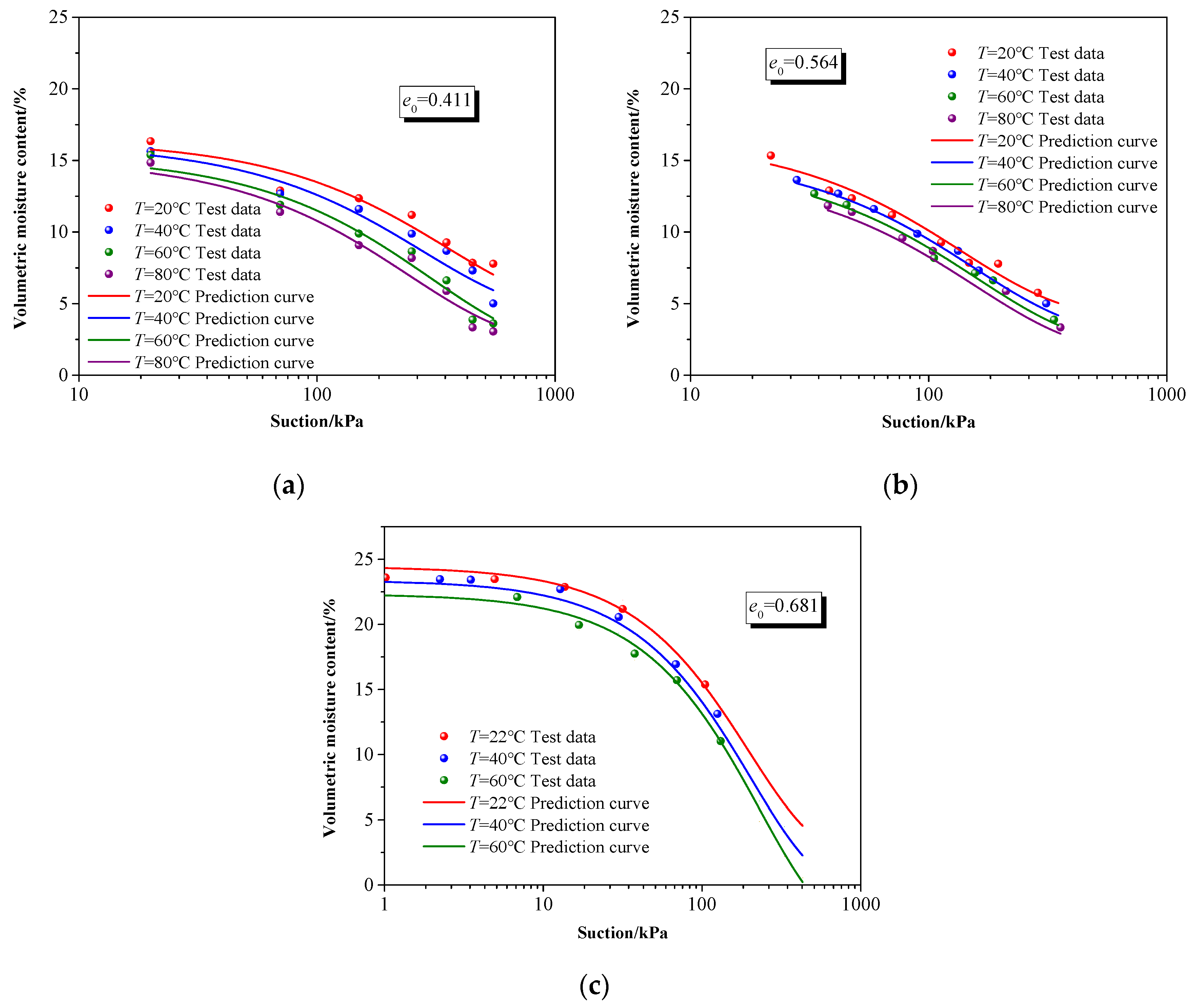
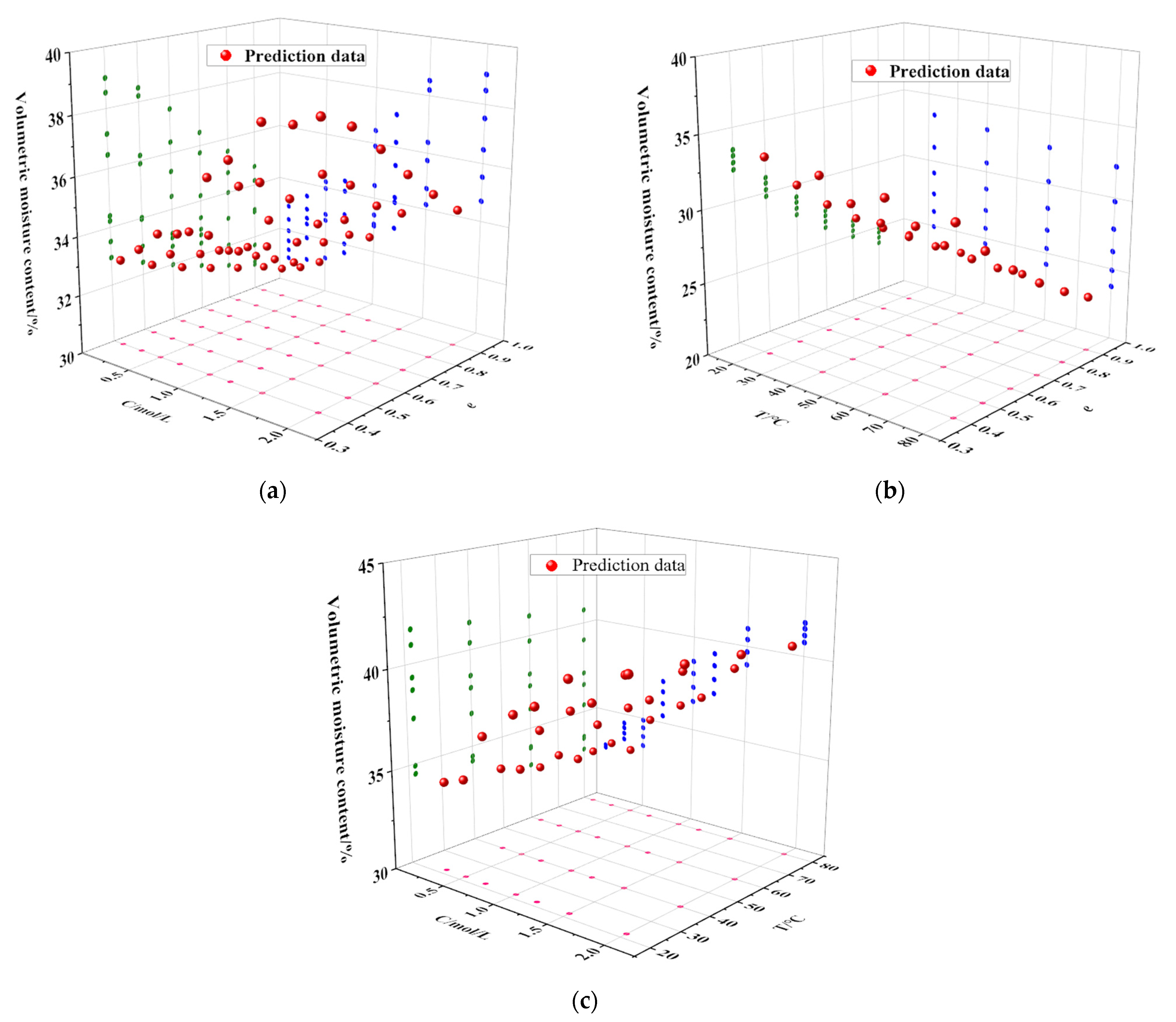

| d10/mm | d30/mm | d60/mm | Ip | w0 | e0 | C/mol·L−1 | s/kPa |
|---|---|---|---|---|---|---|---|
| 0.0026 | 0.021 | 0.061 | 13.6 | 0.27 | 0.7 | 0.5 | 0–5000 |
| d10/mm | d30/mm | d60/mm | Ip | w0 | e0 | C/mol·L−1 | s/kPa |
|---|---|---|---|---|---|---|---|
| 0.003 | 0.018 | 0.053 | 12.25 | 43.6 | 0.7 | 0/0.5/1.0 | 0–550 |
| 0.003 | 0.018 | 0.053 | 12.25 | 37.43 | 0.6 | 0/0.5/1.0 | 0–550 |
| 0.003 | 0.018 | 0.053 | 12.25 | 33.37 | 0.511 | 0/0.5/1.0 | 0–550 |
| 0.003 | 0.018 | 0.053 | 12.25 | 30.14 | 0.432 | 0/0.5/1.0 | 0–550 |
| d10/mm | d30/mm | d60/mm | Ip | w0 | e0 | T/°C | s/kPa |
|---|---|---|---|---|---|---|---|
| 0.0021 | 0.016 | 0.058 | 15.8 | 0.36 | 0.76 | 60 | 0–5000 |
| d10/mm | d30/mm | d60/mm | Ip | w0 | e0 | T/°C | s/kPa |
|---|---|---|---|---|---|---|---|
| 0.0021 | 0.0026 | 0.061 | 13.6 | 17/16/14/13 | 0.411 | 20/40/60/80 | 0–500 |
| 0.0021 | 0.0026 | 0.061 | 13.6 | 14/13/12.5/11.5 | 0.564 | 20/40/60/80 | 0–500 |
| 0.016 | 0.036 | 0.064 | 9.42 | 24/23/22 | 0.681 | 22/40/60 | 0–500 |
| d10/mm | d30/mm | d60/mm | Ip | w0 | e0 | T/°C | C/mol·L−1 | s/kPa |
|---|---|---|---|---|---|---|---|---|
| 0.025 | 0.087 | 0.22 | 12.5 | 35 | 0.4–0.9 | 20–80 | 0 | 150 |
| 0.025 | 0.087 | 0.22 | 12.5 | 25 | 0.4–0.9 | 22 | 0.1–2.0 | 150 |
| 0.025 | 0.087 | 0.22 | 12.5 | 30 | 0.7 | 20–80 | 0.1–2.0 | 150 |
| d10/mm | d30/mm | d60/mm | Ip | w0 | e0 | T/°C | C/mol·L−1 | s/kPa |
|---|---|---|---|---|---|---|---|---|
| 0.003 | 0.018 | 0.053 | 12.25 | 41 | 0.7 | 22 | 1 | 0–1000 |
| 0.003 | 0.018 | 0.053 | 12.25 | 41 | 0.6 | 50 | 0.5 | 0–1000 |
| 0.003 | 0.018 | 0.053 | 12.25 | 41 | 0.4 | 80 | 1.5 | 0–1000 |
| 0.003 | 0.018 | 0.053 | 12.25 | 41 | 0.8 | 60 | 0.1 | 0–1000 |
Disclaimer/Publisher’s Note: The statements, opinions and data contained in all publications are solely those of the individual author(s) and contributor(s) and not of MDPI and/or the editor(s). MDPI and/or the editor(s) disclaim responsibility for any injury to people or property resulting from any ideas, methods, instructions or products referred to in the content. |
© 2024 by the authors. Licensee MDPI, Basel, Switzerland. This article is an open access article distributed under the terms and conditions of the Creative Commons Attribution (CC BY) license (https://creativecommons.org/licenses/by/4.0/).
Share and Cite
Yang, G.; Liu, J.; Liu, Y.; Wu, N.; Liu, T. A Prediction Model for Soil–Water Characteristic Curve Based on Machine Learning Considering Multiple Factors. Buildings 2024, 14, 2087. https://doi.org/10.3390/buildings14072087
Yang G, Liu J, Liu Y, Wu N, Liu T. A Prediction Model for Soil–Water Characteristic Curve Based on Machine Learning Considering Multiple Factors. Buildings. 2024; 14(7):2087. https://doi.org/10.3390/buildings14072087
Chicago/Turabian StyleYang, Guangchang, Jianping Liu, Yang Liu, Nan Wu, and Tingguang Liu. 2024. "A Prediction Model for Soil–Water Characteristic Curve Based on Machine Learning Considering Multiple Factors" Buildings 14, no. 7: 2087. https://doi.org/10.3390/buildings14072087
APA StyleYang, G., Liu, J., Liu, Y., Wu, N., & Liu, T. (2024). A Prediction Model for Soil–Water Characteristic Curve Based on Machine Learning Considering Multiple Factors. Buildings, 14(7), 2087. https://doi.org/10.3390/buildings14072087






